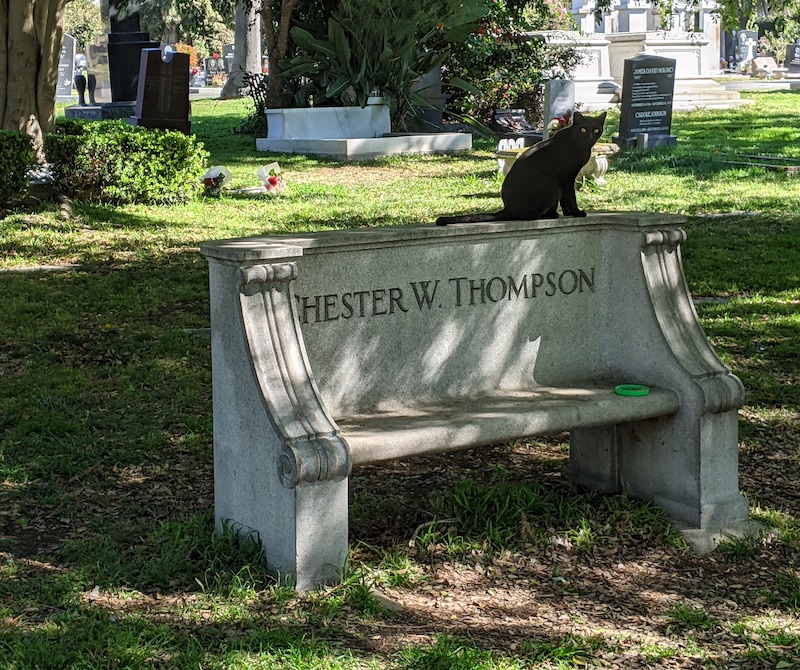
Closeup is a large, black cat who lives at the iconic Hollywood Forever. Karie Bible, who hosts the cemetery’s walking tours, gave the cat his name after noticing he frequently hung out at director and producer Cecil B. DeMille’s grave. It’s a reference to Sunset Boulevard (1950)—in which DeMille played himself—and disgraced film star Norma Desmond’s (Gloria Swanson) famous line, “All right, Mr. DeMille, I’m ready for my close-up.”
Closeup follows Bible around the cemetery as she gives her tours, crunching on the treats she gives him, rolling around in the sun, and soaking up pets from guests. He’s kind of a ham, always posing stoically on a headstone or stretching on a grave marker. Bible maintains his Instagram and that, combined with his friendly demeanor, has made him a minor celebrity in the final resting place of the stars. Some people stop by just to give him treats and scratch his ears.
But the cemetery is actually something of a menagerie. There are no animals buried there—the monument of Terry, the Cairn Terrier who played Toto in The Wizard of Oz, is a cenotaph—but there are even more cats, peacocks, geese, ducks, a pair of swans, families of raccoons, squirrels, possums, rabbits, turtles, and a lake filled with koi. WeLikeLA spoke with the humans who take care of them to learn more about their behavior and how guests can interact with them.
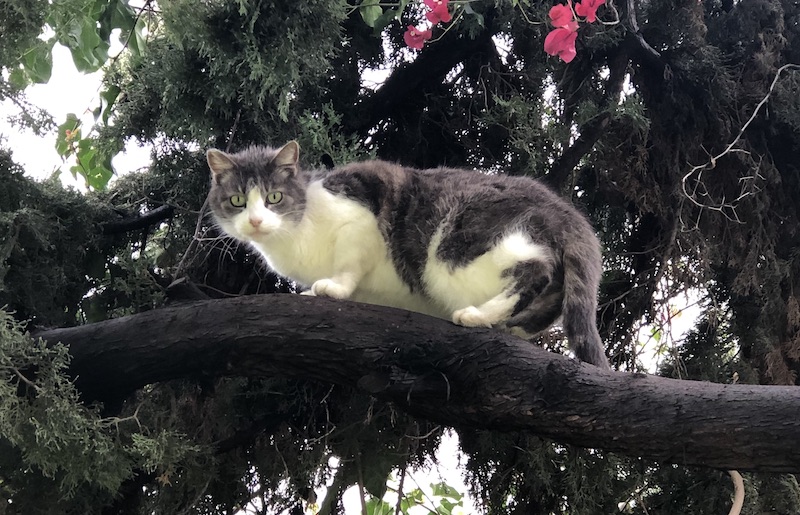
The Cats
As a teen punk rocker in the ‘80s, Michelene Cherie would sneak into the cemetery at night for thrills. By day, she’d frequently visit the graves of Old Hollywood film stars like Rudolph Valentino. In 2007, she noticed two cats that obviously needed medical attention hanging out on the grounds. She and her boyfriend, Nicholas Lynam, borrowed a trap from a stranger on Craigslist and use it to nab both cats and take them to the vet.
She then called the cemetery and asked Jay Boileau, VP of Operations, about the cats. Boileau told her that the cemetery’s cat colony had had a caretaker for many years, but she’d since died and no one had replaced her. Cherie volunteered.
“In 2007, we have over 70 [cats] and it was a challenge. I had never done any animal rescue, and now we’re trying to figure out how, on a 65-acre property, do find all the cats and how do we keep track of them?” Cherie said. “So, I just started setting the traps [to] draw the cats out and, as we had them spayed or neutered, we started a spreadsheet.”
Cherie works with the nonprofit FixNation on Trap, Neuter, Return (TNR) efforts to control the cat population. TNR is exactly what it sounds like. Feral cats first are trapped, usually using a small cage with cat food in it to lure the cat (and sometimes the odd raccoon) inside. The cat then goes to the vet for a checkup and is spayed or neutered before it’s released in the same outdoor area where it was found.
The cats are returned for a few reasons. For one, feral cats that weren’t socialized as kittens are often afraid of people and don’t want to cuddle. They’re hard to adopt into homes, and many who wind up in shelters are killed. Trapping and removing cats also just isn’t effective, according to FixNation: “When cats are removed from a location, it creates a “vacuum” effect — meaning the surrounding cats can sense it and they breed rapidly to fill in the gap, plus new cats move in to take advantage of the natural food and shelter sources.” This vacuum effect is well-documented. Trapping and removing cats often results in having even more unsterilized cats in the location than when you started. Catch and kill is very costly, doesn’t work, and ultimately it’s inhumane.”
In addition to keeping track of which cats had been trapped and fixed, Cherie and Lynam also listed any medical care they received, their ages, and who was related to who so they could “tell who the baby-makers were.”
“It was a lot of observation, just spending hours upon hours in the cemetery just watching. And then the TNR, we do that at night, so we spent many nighttime hours in the cemetery. That’s when the cats really come out and we started taking photos and documenting each section of the cemetery and what animals live there,” she said.
Today, there are about 60 to 65 cats that live in Hollywood Forever, a number that’s remained consistent for several years. Cherie describes the colony as about 98% contained, though there will be the occasional new cat that either wanders in or gets dumped there, which can result in a new litter of kittens. Part of their observation includes noticing the newcomers and determining if they’re friendly and if they need to be fixed.
A few times, Cherie has been able to return a lost cat to its owner, and some 60 cats—mostly kittens—have been adopted. The cemetery has also found homes for a pregnant chihuahua that ended up there, as well as her six puppies. Most adopters find the cats through Hollywood Forever’s social media, then post images of their pets to their own accounts that allow Cherie to watch the animals grow up. Cherie and Lynam have adopted six of the cats themselves, four of whom are still living with the couple today.
When they’re not rescuing cats, Lynam runs a bookkeeping business and Cherie works as an event planner. This includes the cemetery’s annual Dia de los Muertos celebration.
“We’re pretty busy, but we have managed to carve out time over the years to do this because we think it’s important. We love animals and we like helping the cemetery,” she said.
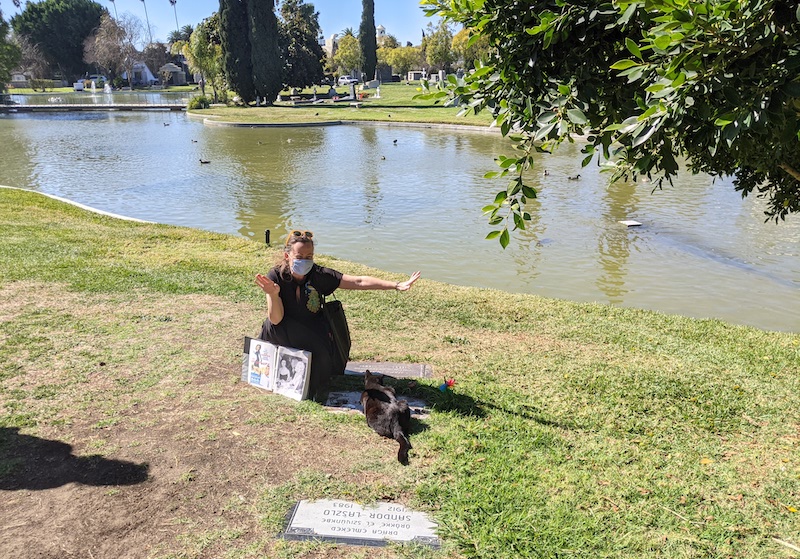
The cats who remain in the cemetery are happy there, with plenty of amenities. They enjoy 10 feeding stations stocked with wet and dry food, plus sleeping shelters and lots of places to hide and play. Visitors also bring a variety of treats for the cats, including one man who Cherie said frequently shows up with a whole chicken.
Closeup is the friendliest of the half-dozen cats that are socialized enough to pet. He’s been at Hollywood Forever for about three years. He was abandoned along with two other black cats and was not always so amicable.
“We used to call him Mr. Growly. He was so feral and territorial that when he ate, he would growl to keep the other cats away. But he’s gotten so much attention that he’s become friendly,” Cherie said.
When Bible renamed the no-longer growly Mr. Growly, the new name stuck. Closeup now spends his days roaming around and hanging out with guests.
“He does visit a lot with people who have loved ones buried there. He seems to have turned into more of a comforting cat to people, an emotional support cat, so to speak. There are several families that he will cuddle up with their laps or sit with them in a chair. And, of course, he gets lots of food and treats. He’s really spoiled,” Cherie said.
Though cats are natural hunters, they live in harmony with the cemetery’s other animals.
“It’s sort of a microcosm of nature. [A]ll of the animals get along really well, and you can observe their respect for each other. The cats don’t go after the birds. In fact, it’s the opposite. Sometimes, the birds will chase the cats around,” Cherie said.
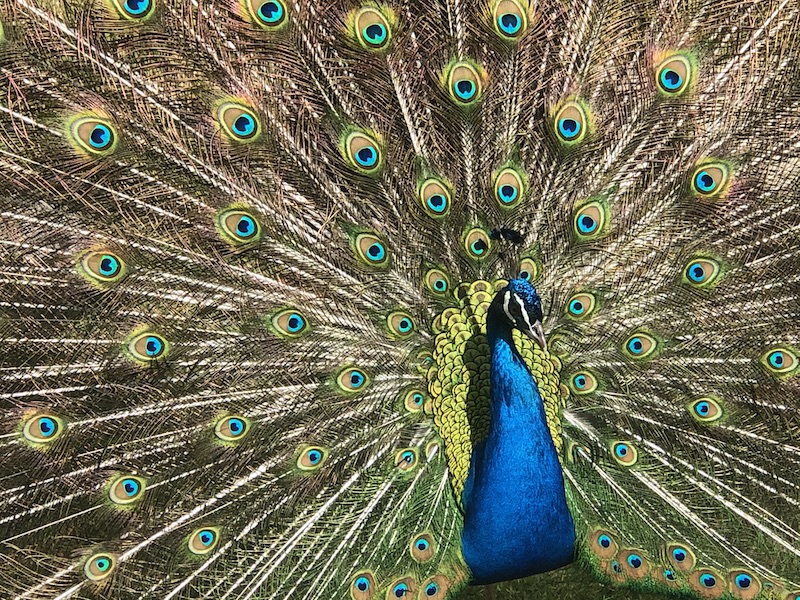
The Birds
Eddie Martinez, a funeral coordinator and crematory technician, confirms this. He said he once observed a group of Muscovy chicks chasing the cats. Martinez takes care of the cemetery’s peacocks and peahens.
“I noticed there wasn’t really somebody that took on the job of taking care of the peacocks and they were treated like any other animals. I wanted to give them a little extra care so I took that upon myself. I enjoy the time with them, it’s like my little zoo over here,” he said. “We all try to keep an eye out for all of the animals and give a helping hand whenever it’s needed. I order the cat food, I order the koi food. Sometimes I’ll go sit by the lake and feed the koi.”
He’s heard various origin stories for why the peacocks arrived, and he’s not sure which is the most accurate. He does know that an employee brought in a few pairs over a decade ago. Over time, some birds have been swapped out just to ensure genetic diversity as they nest, and there are now 53 of them. Generally, you’ll find the birds wandering the grounds from about 7 a.m. to 4 p.m. on weekdays.
“They tend to stick to the front half of the cemetery. They roam around, but they usually stick by the chapel,” he said. “It’s a good place for them. There’s so much space for them to run around.”
At night and on weekends, they live in a hutch near the front wall, adjacent to several of the cats’ feeding stations. The newborns remain in the cage until they’re big enough not to be snagged by hawks. In that time, they bond and form packs.
“You’ll get an idea of who grew up with who just by the little groups,” Martinez said.
They eat a mixture of corn, mealworms, and fruit, and are regularly seen by a vet who trim their nails and wings and gives each bird a checkup
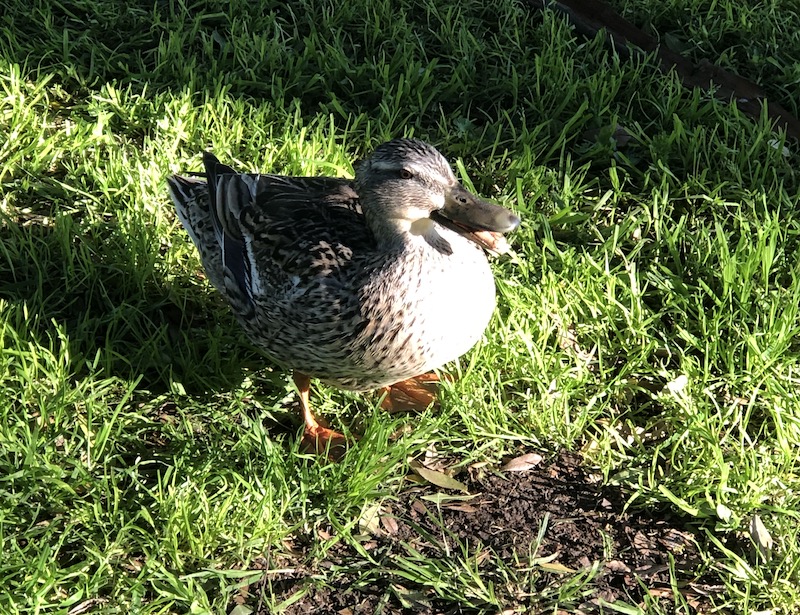
Occasionally, Hollywood Forever will get a call from someone who’s found a peacock and thinks it may live in the cemetery. The calls come from as far away as Marina Del Rey and Torrance, which is likely too far for a Hollywood peacock to have wandered, though, on occasion, the cemetery will take in a stray peacock.
“We try to avoid bringing in other ones, but if it’s a situation where it’s just running in the street and we’re its last hope, then we’ll take it in,” he said.
In addition to the peacocks, Hollywood Forever is home to some East Indie ducks a man rescued and brought to the grounds, as well as other ducks that migrate in and out. This includes the Muscovy ducks, who showed up last year and have since nested. A pair of swans—Zeus and Helen—have lived in the cemetery for eight years. They have nested in the past, but have yet to produce any offspring. This year, Martinez said they’re getting their own private island where they can hopefully raise their first brood.
About four years ago, a crew member recorded a video of several employees, Martinez included, chasing around two loudly crowing roosters that had someone had dumped. The roosters did not remain in the cemetery but went to a crew member’s farm in Palmdale.
“It’s fun to work here and deal with all the animals, and it’s interesting to see the tourists come. They love the cemetery and love the animals. And even more, it’s great to see the interaction between the kids and animals,” he said.
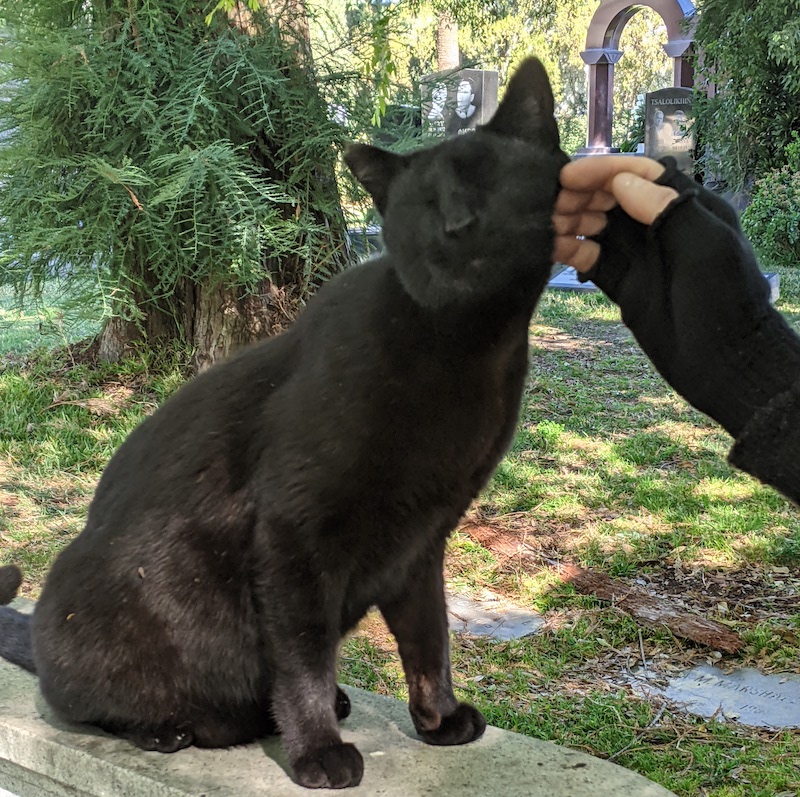
How You Can Interact With the Animals
Because the cemetery is so large, you could totally miss some of the animals if you don’t know where to look.
The cats are most frequently found near the wall near Santa Monica Blvd., next to the peacock cages. They may be hiding in trees or on roofs, but they’re usually easy to spot by the feeding stations. The cats rarely hang out in the buildings or the mausoleum, and Cherie said they’re not fond of the southwest corner of the cemetery that has fewer trees and high places to hide.
Closeup usually comes out if he hears you shake a jar or bag of treats, though Bible told us he may hide if someone is walking their dog nearby. A great way to meet him is to join Bible’s cemetery walking tour, which Closeup frequently attends, plus you’ll get to learn all about the cemetery and Old Hollywood. To get tickets, go here.
When you do see a cat, Cherie advises, “Don’t chase them and just be respectful. They’re hanging out doing their thing, sleeping, and just being mellow. If you’re going to approach, just do so calmly and quietly. They do like treats, so you can bring them things if you like. They love that cat paste—that’s one way to approach some of the friendlier cats or the slightly timid ones. If you’re going to try to pet them, know that they are technically wild animals and could be mercurial, so do it with caution. Do it slowly, and if they don’t like it, don’t do it.”
The cemetery also hosts several yoga classes each week where participants are spread out over two acres in the area where Cinespia takes place. Occasionally, yoga instructor Mary DeCaro will conduct “kitty yoga” classes, a fundraiser for the Hollywood Forever cat colony’s care and for FixNation. To find out when the next yoga class is, go here. To find out when the next kitty yoga class is, follow DeCaro’s Instagram account. You can also follow Hollywood Forever here to find out more about upcoming adoption fairs and events.
As for the birds, they can be found in the lake area, near the chapel, and in the peacock cages if it’s the weekend. Martinez said you can feed the ducks, but with care.
“Just be conscious of what you’re feeding them. You don’t want to give them Hot Cheetos and stuff like that. Just give them something proper that they can eat that won’t be bad for their health and that’s really it. Be considerate of the animals, do your best to care for them, and consider that they’re still wild animals,” he said.
advertisements
